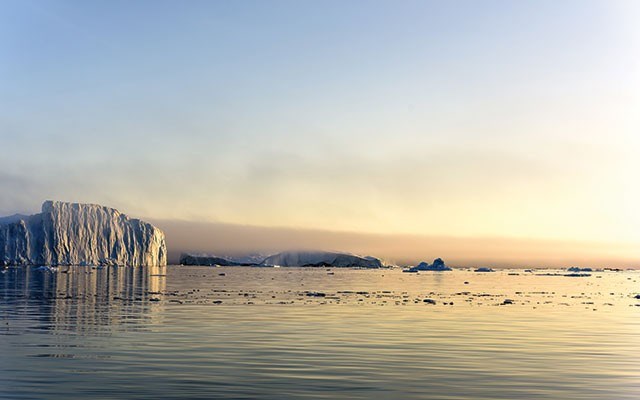Perhaps I'd been reading too much about climate change. Perhaps stories about the world's polar regions warming the fastest made me think that cruising through the Northwest Passage would be easy, the marine equivalent of a walk in the park.Whatever the reason, it's fair to say I had no idea what was awaiting as I prepared to join Adventure Canada's Ocean Endeavour, on one of its two annual expeditions through the passage.
We board the 198-passenger ship in Kugluktuk, Nunavut, for our west to east traverse. In early September, the tundra is already tinged red. Winter is coming, but September is also the best month for sailing in the Arctic; it's the sweet spot between last year's ice melting and this year's forming. The wind begins soon after we depart. Two days into the trip, it's gale force and we can't stop at Gjoa Haven, where Roald Amundsen overwintered on his historic first crossing of the passage. "Stay off the decks," warns our expedition leader.
For the next two and a half days, we're ship-bound, the wind howling, rain turning to snow, the outside handrails sheathed in ice like one of those God-forsaken, 19th-century expeditions that ended trapped in ice.
We lurch through the ship's hallways like we've had one drink too many. We sit through back-to-back lectures. We eat too many cookies out of boredom. At night, we roll in our beds as the ship heaves to and fro, the sound of clanking metal interrupting sleep.
Rounding King William Island, we head north to Bellot Strait, a narrow channel where the Atlantic and Pacific meet, and where the North American continent comes to its northern-most point. Bundled up, we spill onto the ship's decks, scanning the cliffs and water for muskox, polar bear, narwhal and beluga.
It was at the eastern end of Bellot Strait that the Hudson's Bay Company built its last Arctic trading post in 1937. When the wind finally calms, we go ashore by zodiac to explore long-abandoned Fort Ross. The land here is treeless, of course, and more dramatic because of it. Orange, lichen-covered boulders are dusted with the season's first snow. Dark clouds brood on the horizon. It feels wonderful to feel solid ground underfoot. Inside the former manager's house, wallpaper peels from the walls and snow covers the floor and furniture in artful drifts.
The next day we go ashore again, this time to Beechey Island, where we sombrely inspect three graves from the Captain Sir John Franklin doomed expedition, then — forgive us, men — turn to admire the stunning seascape before us. Turquoise ice floes bob along the shoreline and grey clouds swoop down to meet the silver sea. We trudge through deep snow with almost military precision, appearing — I imagine — a little like Franklin's crew out for a walk when they wintered here in 1845-46, still optimistic they would find the fabled passage.
But our most exciting moments aren't on land, but on the ship. Early one morning, we throw parkas over pj's and hurry outside where a solitary bear walks across a mass of large, slushy ice floes. A couple mornings later someone spots another bear. This one is restless; climbing over blocks of ice, falling into the water, climbing back on, eating snow, rubbing her backside, and then — at her most adorable moment of the morning — lying on her back and lifting one hind leg to her face like a person stretching after a run.
When ice prevents us from going ashore at Grise Fiord, Canada's most northerly community, we visit Arctic Bay instead, where locals zip past on snowmobiles and ATVs. One man stops to show us a narwhal tusk. He'll sell it for $2,500. Later, I see a passenger carrying it onto our ship.
Crossing Baffin Bay to Greenland, the Arctic isn't finished with us yet. Waves explode over the ship's bow. A peregrine falcon takes refuge on the top deck. We're past being surprised when fog, wind, snow or ice — and sometimes all four — prevent us from going ashore. Yet this same weather produces the most magnificent panoramas. I stand on deck for hours, mesmerized by the moody black-and-white gallery of clouds, water and ice.
Then, suddenly, the weather clears. Half a dozen King Eider ducks herald our arrival at Upernavik, a picturesque town of 1,100 people (and even more sled dogs) on a hillside overlooking Davis Strait. Further south, we spend a glorious sunny day at the Ilulissat Icefjord, a UNESCO World Heritage site, where the fastest moving and most productive glacier outside of Antarctica calves enormous icebergs into the ocean.
"Every time I come here it blows my mind," says David Reid, one of the ship's crew. "Look at that," he says, admiring the ice-jammed fjord. "Beautiful." That evening, we cruise by zodiac amongst the towering icebergs, dwarfed by their splendour, awed by their frozen majesty. Just when we thought it couldn't get any better, three humpback whales break the surface.
Like the Inuit who've gone before us, we've learned not to take anything about the Arctic for granted. So on our last night, when the black sky shimmers with a green aurora from one horizon to the other, we feel extra lucky. We've loved everything the Arctic has thrown at us, even if it was more than we imagined.
If you go:
Dates for this year's expeditions with Adventure Canada (www.adventurecanada.com) through the Northwest Passage expeditions are Aug. 22 to Sept. 7 and Sept. 7 to 23. Rates start at US$8,995 per person. and include all meals, onshore adventures and onboard programming. There's no single supplement for most categories of room. Guests under 30 qualify for a 30-per-cent discount. Rental bicycles are available on-board and are a great way to explore when you go ashore. The Ocean Endeavour is a 198-passenger, ice-strengthened expedition vessel.




